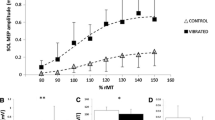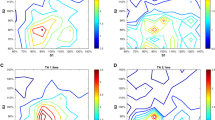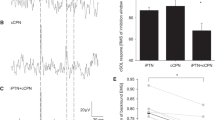Abstract
Motor-evoked potentials (MEP) in the tibialis anterior (TA) muscle were shown to be facilitated by repetitive electrical stimulation of the common peroneal (CP) nerve at intensities above motor threshold. The TA electromyogram (EMG) and ankle flexion force were recorded in response to transcranial magnetic stimulation (TMS) of the leg area of the motor cortex to evaluate the excitability of cortico-spinal-muscular pathways. Repetitive stimulation of the CP nerve at 25 Hz for 30 min increased the MEP by 50.3 ± 13.6% (mean ± S.E.) at a TMS intensity that initially gave a half-maximum MEP (MEPh). In contrast the maximum MEP (MEPmax) did not change. Ankle flexion force (103 ± 21.9%) and silent period duration (75.3 ± 12.9%) also increased. These results suggest an increase in corticospinal excitability, rather than total connectivity due to repetitive CP stimulation. Facilitation was evident after as little as 10 min of stimulation and persisted without significant decrement for at least 30 min after stimulation. The long duration of silent period following CP stimulation (99.2 ± 14.8 ms) suggests that this form of stimulation may have effects on the motor cortex. To exclude the possibility that MEPh facilitation was primarily due to sensory fibre activation, we performed several control experiments. Preferentially activating Ia muscle afferents by vibration in the absence of motor activity had no significant effect. Cutaneous afferent activation via stimulation of the superficial peroneal nerve increased the amplitude of responses at MEPmax rather than MEPh. Concurrent tendon vibration and superficial peroneal nerve stimulation failed to facilitate TA MEP responses. In summary, repetitive electrical stimulation of the CP nerve elicits lasting changes in corticospinal excitability, possibly as a result of co-activating motor and sensory fibres.






Similar content being viewed by others
References
Awiszus F, Feistner H (1994) Quantification of D- and I-wave effects evoked by transcranial magnetic brain stimulation on the tibialis anterior motoneuron pool in man. Exp Brain Res 101:153–158
Bertasi V, Bertolasi L, Frasson E, Priori A (2000) The excitability of human cortical inhibitory circuits responsible for the muscle silent period after transcranial brain stimulation. Exp Brain Res 132:384–389
Bütefisch CM, Davis BC, Wise SP, Sawaki L, Kopylev L, Classen J, Cohen LG (2000) Mechanisms of use-dependent plasticity in the human motor cortex. Proc Natl Acad Sci U S A 97:3661–3665
Capaday C, Cooke JD (1981) The effects of muscle vibration on the attainment of intended final position during voluntary human arm movements. Exp Brain Res 42:228–230
Capaday C, Lavoie BA, Barbeau H, Schneider C, Bonnard M (1999) Studies on the corticospinal control of human walking. I. Responses to focal transcranial magnetic stimulation of the motor cortex. J Neurophysiol 81:129–139
Chen R, Cohen LG, Hallett M (2002) Nervous system reorganization following injury. Neuroscience 111:761–763
Classen J, Liepert J, Wise SP, Hallett M, Cohen LG (1998) Rapid plasticity of human cortical movement representation induced by practice. J Neurophysiol 79:1117–1123
Devanne H, Lavoie BA, Capaday C (1997) Input-output properties and gain changes in the human corticospinal pathway. Exp Brain Res 114:329–338
Di Lazzaro V, Oliviero A, Profice P, Meglio M, Cioni B, Tonali P, Rothwell JC (2001) Descending spinal cord volleys evoked by transcranial magnetic and electric stimulation of the motor cortex leg area in conscious humans. J Physiol 537:1047–1058
Elbert T, Pantev C, Wienbruch C, Rockstroh B, Taub E (1995) Increased cortical representation of the fingers of the left hand in string players. Science 270:305–307
Fraser C, Power M, Hamdy S, Rothwell J, Hobday D, Hollander I, Tyrell P, Hobson A, Williams S, Thompson D (2002) Driving plasticity in human adult motor cortex is associated with improved motor function after brain injury. Neuron 34:831–840
Fuhr P, Agostino R, Hallett M (1991) Spinal motor neuron excitability during the silent period after cortical stimulation. Electroencephalogr Clin Neurophysiol 81:257–262
Garvey MA, Ziemann U, Becker DA, Barker CA, Bartco JJ (2001) New graphical method to measure silent periods evoked by transcranial magnetic stimulation. Clin Neurophysiol 112:1451–1460
Hamdy S, Rothwell JC, Aziz Q, Singh KD, Thompson DG (1998) Long-term reorganization of human motor cortex driven by short-term sensory stimulation. Nat Neurosci 1:64–68
Ikeda A, Ohara S, Matsumoto R, Kunieda T, Nagamine T, Miyamoto S, Kohara N, Taki W, Hashimoto N, Shibaski H (2000) Role of primary sensorimotor cortices in generating inhibitory motor responses in humans. Brain 123:1710–1721
Irlbacher K, Meyer BU, Voss M, Brandt SA, Roricht S (2002) Spatial reorganization of cortical motor output maps of stump muscles in human upper-limb amputees. Neurosci Lett 321:129–132
Kaelin-Lang A, Luft AR, Sawaki L, Burstein AH, Sohn YH, Cohen LG (2002) Modulation of human corticomotor excitability by somatosensory input. J Physiol 540:623–633
Kaji R, Rothwell JC, Katama M, Ikeda T, Kubori T, Kohara N, Mezaki T, Shibasaki H, Kimura J (1995). Tonic vibration reflex and muscle afferent block in writers cramp. Ann Neurol 38:155–162
Khaslavskaia S, Ladoucer M, Sinkjaer T (2002) Increase in tibialis anterior motor cortex excitability following repetitive electrical stimulation of the common peroneal nerve. Exp Brain Res 145:309–315
Kossev A, Siggelkow S, Kapels H, Dengler R, Rollnik JD (2001) Crossed effects of muscle vibration on motor-evoked potentials. Clin Neurophysiol 112:453–456
Lentz M, Nielson JF (2002) Post-exercise facilitation and depression of M wave and motor evoked potentials in healthy subjects. Clin Neurophysiol 113:1092–1098
Macefield VG, Gandevia SC, Bigland-Ritchie B, Gorman RB, Burke D (1993) The firing rates of human motoneurons voluntarily activated in the absence of muscle afferent feedback. J Physiol 471:429–443
Nielson J, Peterson N, Fedirchuk B (1997) Evidence suggesting a transcortical pathway from cutaneous foot afferents to tibialis anterior motoneurons in man. J Physiol 501:473–484
Onishi H, Yagi R, Akasaka K, Momose K, Ihashi K, Handa Y (2000) Relationship between EMG signals and force in human vastus lateralis muscle using multiple bipolar wire electrodes. J Electromyogr Kinesiol 10:59–67
Pitcher JB, Miles TS (2002) Alterations in corticospinal excitability with imposed vs. voluntary fatigue in human hand muscles. J Appl Physiol 92:2131–2138
Ridding MC, Rothwell JC (1995) Reorganization in human motor cortex. Can J Physiol Pharmacol 73:218–222
Ridding MC, Taylor JL (2001) Mechanisms of motor-evoked potential facilitation following prolonged dual peripheral and central stimulation in humans. J Physiol 537:623–631
Ridding MC, Brouwer MC, Miles TS, Pitcher JB, Thompson PD (2000) Changes in muscle responses to stimulation of the motor cortex induced by peripheral nerve stimulation in human subjects. Exp Brain Res 131:135–143
Ridding MC, McKay DR, Thompson PD, Miles TS (2001) Changes in corticomotor representations induced by prolonged peripheral nerve stimulation in humans. Clin Neurophysiol 112:1461–1469
Sacco P, Thickbroom GW, Thompson ML, Mastaglia FL (1997) Changes in corticomotor excitation and inhibition during prolonged submaximal muscle contractions. Muscle Nerve 20:1158–1166
Samii A, Wassermann EM, Ikoma K, Mercuri B, Hallett M (1996) Characterization of postexercise facilitation and depression of motor evoked potentials to transcranial magnetic stimulation. Neurology 46:1376–1382
Schnitzler A, Benecke R (1994) The silent period after transcranial magnetic stimulation is of exclusive cortical origin: evidence from isolated cortical ischemic lesions in man. Neurosci Lett 180:41–45
Shimizu T, Hino T, Komori T, Harris S (2000) Loss of the muscle silent period evoked by transcranial magnetic stimulation of the motor cortex in patients with cervical cord lesions. Neurosci Lett 286:199–202
Sinkjaer T, Khaslavskaia S (2002) Tibialis anterior motor cortex excitability following repetitive electrical stimulation (RES) of CP nerve depends on the voluntary motor cortical drive during the time of RES. Soc Neurosci Abst 562.4
Stefan K, Kunesch E, Benecke R, Cohen LG, Classen J (2002) Mechanisms of human motor cortical plasticity induced by interventional paired associative stimulation. J Physiol 543:699–708
Taylor JL, Gandevia SC (2001) Transcranial magnetic stimulation and human muscle fatigue. Muscle Nerve 24:18–29
Tinazzi M, Farina S, Tamburin S, Facchini S, Fiaschi A, Restivo D, Berardelli A (2003) Task-dependent modulation of excitatory and inhibitory functions within the human primary motor cortex. Exp Brain Res 150:222–229
Totosy de Zepetnek JE, Gordon T, Stein RB, Zung HV (1991) Comparison of force and EMG measures in normal and reinnervated tibialis anterior muscles of the rat. Can J Physiol Pharmacol 69:1774–1783
Trompetto C, Buccolieri A, Marinelli L, Abbruzzese G (2001) Differential modulation of motor evoked potential and silent period by activation of intracortical inhibitory circuits. Clin Neurophysiol 112:1822–1827
Wieler M, Stein RB, Ladouceur M, Whittaker M, Smith AW, Naaman S, Barbeau H, Bugaresti J, Aimone E (1999) Multicenter evaluation of electrical stimulation systems for walking. Arch Phys Med Rehabil 80:495–500
Windhorst U (1996) On the role of recurrent inhibitory feedback in motor control. Prog Neurobiol 49:517–587
Zehr EP, Fujita K, Stein RB (1998) Reflexes from the superficial peroneal nerve during walking in stroke subjects. J Neurophysiol 79:848–858
Ziemann U, Netz J, Szelenyi A, Homberg V (1993) Spinal and supraspinal mechanisms contribute to the silent period in the contracting soleus muscle after transcranial magnetic stimulation of human motor cortex. Neurosci Lett 156:167–171
Ziemann U, Hallett M, Cohen LG (1998) Mechanisms of deafferentation-induced plasticity in human motor cortex. J Neurosci 18:7000–7007
Ziemann U, Muellbacher W, Hallet M, Cohen LG (2001) Modulation of practice-dependent plasticity in human motor cortex. Brain 124:1171–1181
Zijdewint I, Zwarts MJ, Kernell D (2000) Potentiating and fatiguing cortical reactions in a voluntary fatigue test of a human hand muscle. Exp Brain Res 130:529–532
Acknowledgements
We thank Dr. Doug Weber for his assistance with statistical analysis and Dr. Charles Capaday for his suggestions. This research was supported by the Canadian Institutes of Health Research.
Author information
Authors and Affiliations
Corresponding author
Rights and permissions
About this article
Cite this article
Knash, M.E., Kido, A., Gorassini, M. et al. Electrical stimulation of the human common peroneal nerve elicits lasting facilitation of cortical motor-evoked potentials. Exp Brain Res 153, 366–377 (2003). https://doi.org/10.1007/s00221-003-1628-9
Received:
Accepted:
Published:
Issue Date:
DOI: https://doi.org/10.1007/s00221-003-1628-9




